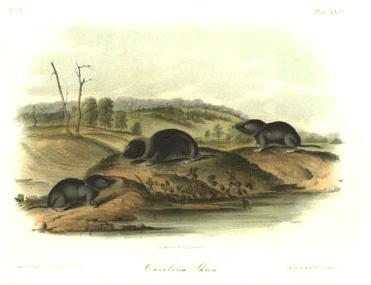

75 Carolina Shrew
SOREX CAROLINENSIS.--Bacit.
[Blarina carolinensis]
CAROLINA SHREW. MALES AND FEMALES.
[Southern Short-tailed Shrew]
PLATE LXXV.
S. carolinensis, corpore griseo--cinerascente; cauda brevis, depressa.
CHARACTERS.
Carolina Shrew, with a short flat tail; cars not visible; body of a nearly
uniform iron grey colour.
DESCRIPTION.
2
Intermediary incisors ---- -
2
5-5 5-5
Lateral incisors ---; Molars, --- = 34.
2-2 3-3
The four front teeth are yellowish white, with their points deeply tinged
with chesnut brown; all the rest are brown, a little lighter near the sockets.
The upper intermediary incisors have each, as is the case in most other species
of this genus, an obtuse lobe, which gives them the appearance of having a small
tooth growing out from near the roots. The three lateral incisors are largest;
the posterior ones very small; the first and fifth grinders are the smallest;
the other three nearly equal. In the lower jaw the two first teeth are lobed;
the lateral incisors are comparatively large, and crowded near the grinders.
The molars are bristled with sharp points except the last, which is a
tuberculous tooth.
The muzzle is moderately long and slender, and pointed with a naked deep
lobed lip. The whiskers are composed of hairs apparently all white, a few of
those situated in front of the eyes extending to the occiput, the rest rather
short. There are no visible ears, even where the fur is removed; the auditory
opening is an orifice situated far back on the sides of the head running
obliquely. The orifice of the eye is so small that it can only be discovered by
the aid of a good magnifying glass. The tail is flat, thickly covered with a
coat of close hair, and terminated by a small pencil of hairs. The fore feet
are rather broad for this genus, measuring a line and a half in breadth,
resembling in some respects those of the shrew mole, (Scalops canadensis.) The
toes are five, the inner a little shorter than the outer one; the third and
fourth, nearly equal. The nails are sharp, rather long, a little arched, but
not hooked. The hind feet are more slender than the fore ones; naked beneath,
and covered above, as are also the fore feet, by a thin coat of short adpressed
hairs.
COLOUR.
The fur presents the beautiful velvety appearance common to most species of
this genus. The colour of the whole body is nearly uniform, considerably
lustrous on the upper surface, and in most lights dark iron gray, rather darker
about the head; on the under surface the fur is of nearly the same general
appearance, but is a shade lighter.
DIMENSIONS.
Inches.
Length of body. . . . . . . . . . . 3
Length of tail. . . . . . . . . . . 5/8
Length of head. . . . . . . . . . . 1
Length of palm to the end of nails . . . . 5/16
Length of hind feet . . . . . . . . . 1/2
HABITS.
It is difficult to know much of the habits of the little quadrupeds
composing this genus. Living beneath the surface of the earth, feeding
principally on worms and the larva of insects, shunning the light, and
restricted to a little world of their own, best suited to their habits and
enjoyments, they almost present a barrier to the prying curiosity of man. They
are occasionally turned up by the plough on the plantations of the south, when
they utter a faint, squeaking cry, like young mice, and make awkward and
scrambling attempts to escape, trying to conceal themselves in any tuft of
grass, or under the first clod of earth that may present itself. On two
occasions, their small but compact nests were brought to us, they were composed
of fibres of roots and withered blades of various kinds of grasses. They had
been ploughed up from about a foot beneath the surface of the earth, and
contained in one nest five, and in the other six young. In digging ditches, and
ploughing in moderately high grounds, small holes are frequently seen running in
all directions, in a line nearly parallel with the surface, and extending to a
great distance, evidently made by this species. We observed on the sides of one
of these galleries, a small cavity containing a hoard of coleopterous insects,
principally composed of a rare species (Scaraboeus tityus), fully the size of
the animal itself; some of them were nearly consumed and the rest mutilated,
although still living.
GEOGRAPHICAL DISTRIBUTION.
This quadruped is found in various localities, both in the upper and
maritime districts of South Carolina. We recently received specimens from our
friend Dr. BARRETT, of Abbeville District; and we have been informed by Dr.
PICKERING, to whose inspection we submitted a specimen, and who pronounced it
undoubtedly an undescribed species, that it had been observed as far north as
Philadelphia.
|